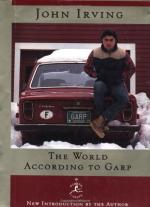|
This section contains 10,087 words (approx. 34 pages at 300 words per page) |

|
SOURCE: Shostak, Debra. “Plot as Repetition: John Irving's Narrative Experiments.” Critique: Studies in Contemporary Fiction 37, no. 1 (fall 1995): 51-70.
In the following essay, Shostak analyses how Irving's body of work—particularly The World according to Garp—displays his tragic-comic vision, narrative technique, fictional form, and recurring motifs.
Sorrow floats. So claims the narrator of John Irving's novel, The Hotel New Hampshire (1981). Sorrow is the flatulent Labrador retriever who dies but does not disappear, the free-floating dog of anxiety whose remains come to the surface even after the airplane he rides in plunges into the sea. Sorrow is the return of the repressed, punning reminder and even cause of the violence that is our human lot (one of his postmortem appearances sends a family member into cardiac arrest), and his visitations provide a symbolic structure for John Berry's narration of the Berry family's lives.
Sorrow's repetitions in the narrative of...
|
This section contains 10,087 words (approx. 34 pages at 300 words per page) |

|


